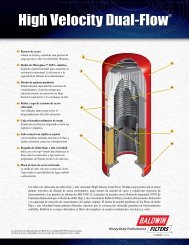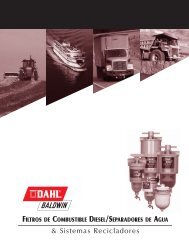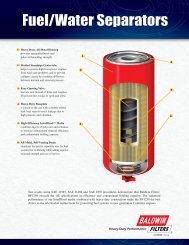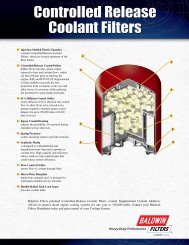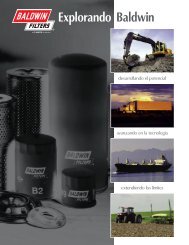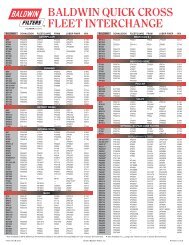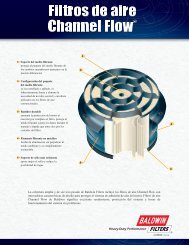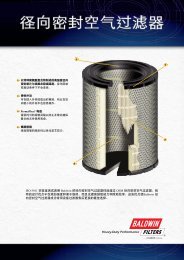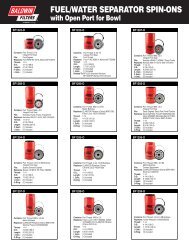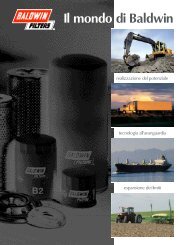MSDS G44 - Baldwin Filters
MSDS G44 - Baldwin Filters
MSDS G44 - Baldwin Filters
Create successful ePaper yourself
Turn your PDF publications into a flip-book with our unique Google optimized e-Paper software.
<strong>MSDS</strong> <strong>G44</strong><br />
Effective Date: 5-Mar-2012<br />
This Material Safety Data Sheet applies to the following <strong>Baldwin</strong> <strong>Filters</strong> Part Numbers:<br />
BW5136<br />
BW5137<br />
BW5138<br />
BW5139<br />
BW5140<br />
I. Product and Company Identification<br />
Emergency Only Telephone: (800) 424-9300 Inside the US, Canada and the U.S. Virgin Islands<br />
(703) 527-3887 Outside the US (collect calls accepted)<br />
Information Telephone: (800) 822-5394<br />
II. Hazards Identification<br />
BW5141<br />
BW5142<br />
BW5143<br />
BW5178<br />
BW5179<br />
BW5182<br />
BW5183<br />
Physical State:<br />
Color:<br />
Odor:<br />
Emergency Overview<br />
Signal Word:<br />
Hazard Statements:<br />
Precautions:<br />
OSHA/HCS Status:<br />
Routes of Entry:<br />
Solid [Pellet]<br />
White to Yellowish<br />
Slight<br />
DaNGEr!<br />
COrrOSIVE MaTErIaL. HarMFUL Or FaTaL IF INHaLED. HarMFUL Or FaTaL IF<br />
SWaLLOWED. MaY CaUSE SEVErE BUrNS TO aLL rOUTES OF EXPOSUrE.<br />
CONTaINS MaTErIaL WHICH CaN CaUSE CaNCEr. CONTaINS MaTErIaL THaT<br />
MaY CaUSE aDVErSE rEPrODUCTIVE EFFECTS, BaSED ON aNIMaL DaTa.<br />
CONTaINS MaTErIaL THaT MaY aDVErSELY aFFECT THE DEVELOPING FETUS.<br />
Do not breathe dust. Do not ingest. avoid contact with eyes and skin. Use only with<br />
adequate ventilation. Keep container tightly closed and sealed until ready for use. Wash<br />
thoroughly after handling.<br />
This material is considered hazardous by the OSHa Hazard Communications Standard<br />
(29 CFr 1910.1200).<br />
Dermal contact. Eye Contact. Inhalation. Ingestion.<br />
Potential Acute Health Effects<br />
Eyes:<br />
Corrosive to the eyes. Causes burns.<br />
Skin:<br />
Corrosive to the skin. Causes burns.<br />
Ingestion:<br />
Harmful or fatal if swallowed. May cause corrosive damage in the mouth, throat and<br />
stomach.<br />
Inhalation:<br />
Harmful or fatal if inhaled. Corrosive to the respiratory tract. Symptoms may be delayed.<br />
Potential Chronic Health Effects<br />
Chronic Effects:<br />
Contains material that may cause target organ damage, based on animal data.<br />
Carcinogenicity:<br />
Contains material that can cause cancer. risk of cancer depends on duration and level<br />
of exposure.<br />
Mutagenicity:<br />
No known significant effects or critical hazards.
Teratogenicity:<br />
Developmental Effects:<br />
Fertility Effects:<br />
Target Organs:<br />
Contains material that has been investigated as a developmental hazard.<br />
Contains material which may cause developmental abnormalities, based on animal data.<br />
Contains material which may impair fertility, based on animal data.<br />
Contains material which may cause damage to the following organs: kidneys, the<br />
reproductive system, mucous membranes, upper respiratory tract, skin, eyes, central<br />
nervous system (CNS), nose/sinuses.<br />
Over-Exposure Signs/Symptoms<br />
Inhalation:<br />
adverse symptoms may include the following: respiratory tract irritation, coughing<br />
Ingestion:<br />
adverse symptoms may include the following: stomach pains<br />
Skin:<br />
adverse symptoms may include the following: Pain or irritation, redness, blistering may occur<br />
Eyes:<br />
adverse symptoms may include the following: pain, watering, redness<br />
Medical Conditions<br />
Generally Aggravated<br />
by Exposure:<br />
Pre-existing disorders involving any target organs mentioned in this <strong>MSDS</strong> as being at<br />
risk may be aggravated by over-exposure to this product.<br />
III. Composition/Information on Ingredients<br />
United States<br />
Ingredient CAS Number % by Weight<br />
Sodium nitrite 7632-00-0 30-60<br />
Disodium trioxosilicate 6834-92-0 10-30<br />
Benzotriazole 95-14-7 5-10<br />
Disodium tetraborate, anhydrous 1330-43-4 5-10<br />
Octadecanoic acid, magnesium salt (2:1) 557-04-0 1-5<br />
Sodium nitrate 7631-99-4 0.1-1<br />
1(3H)-Isobenzofuranone, 3,3-bis(4-hydroxyphenyl) 77-09-8 0.1-1<br />
Canada<br />
Ingredient CAS Number % by Weight<br />
Sodium nitrite 7632-00-0 30-60<br />
Disodium trioxosilicate 6834-92-0 10-30<br />
Disodium tetraborate, anhydrous 1330-43-4 5-10<br />
Octadecanoic acid, magnesium salt (2:1) 557-04-0 1-5<br />
1(3H)-Isobenzofuranone, 3,3-bis(4-hydroxyphenyl) 77-09-8 0.1-1<br />
Mexico<br />
Classification<br />
Name UN Number IDLH H F R Special CAS Number %<br />
Sodium nitrite UN1500 - 4 0 0 OX 7632-00-0 30-60<br />
Disodium trioxosilicate UN1759 - 3 0 1 6834-92-0 5-10<br />
Octadecanoic acid,<br />
magnesium salt (2:1) Not regulated - 1 0 0 557-04-0 1-5<br />
Disodium tetraborate,<br />
anhydrous Not regulated - 0 0 0 1330-43-4 5-10<br />
There are no additional ingredients present which, within the current knowledge of the supplier and in the concentrations<br />
applicable, are classified as hazardous to health or the environment and hence require reporting in this section.<br />
See Section 8 for Exposure Limits.<br />
See Section 11 for Toxiciological Data.<br />
IV. First Aid Measures<br />
2 <strong>G44</strong>
Eye Contact:<br />
Skin Contact:<br />
Ingestion:<br />
Inhalation:<br />
Protection of<br />
First-Aiders:<br />
Notes to Physician:<br />
Check for and remove any contact lenses. In case of contact, immediately flush eyes<br />
with plenty of water for at least 20 minutes. Get medical attention immediately.<br />
In case of contact, immediately flush skin with plenty of water for at least 20 minutes<br />
while removing contaminated clothing and shoes. Get medical attention immediately.<br />
Do not induce vomiting. Never give anything by mouth to an unconscious person. Get<br />
medical attention immediately.<br />
If inhaled, remove to fresh air. If not breathing give artificial respiration If breathing is<br />
difficult, give oxygen. Get medical attention immediately.<br />
No action shall be taken involving any personal risk or without suitable training. If it is<br />
suspected that fumes are still present, the rescuer should wear an appropriate mask or<br />
self-contained breathing apparatus. It may be dangerous to the person providing aid to<br />
give mouth-to-mouth resuscitation. Wash contaminated clothing thoroughly with water<br />
before removing it, or wear gloves.<br />
In case of inhalation of decomposition products in a fire, symptoms may be delayed. The<br />
exposed person may need to be kept under medical surveillance for 48 hours.<br />
V. Fire-Fighting Measures<br />
Flammability of<br />
the Product:<br />
Extinguishing Media<br />
Suitable:<br />
Not Suitable:<br />
Special Exposure<br />
Hazards:<br />
Hazardous Thermal<br />
Decomposition Products:<br />
Special Protective<br />
Equipment for<br />
Fire-Fighters:<br />
Not flammable. However, this product contains a strong oxidizer, sodium nitrite, which<br />
enhances the burning rate of other materials.<br />
Use dry chemical, CO2, water spray (fog) or foam.<br />
None known.<br />
Promptly isolate the scene by removing all persons from the vicinity of the incident if<br />
there is a fire. No action shall be taken involving any personal risk or without suitable<br />
training.<br />
Decomposition products may include the following materials: carbon dioxide, carbon<br />
monoxide, nitrogen oxides, metal oxide/oxides, toxic fumes<br />
Fire-fighters should wear appropriate protective equipment and self-contained breathing<br />
apparatus (SCBa) with a full face-piece operated in positive pressure mode.<br />
VI. Accidental Release Measures<br />
Personal Precautions:<br />
Environmental Precautions:<br />
Methods for Cleaning Up<br />
Small Spill:<br />
No action shall be taken involving any personal risk or without suitable training. Evacuate<br />
surrounding areas. Keep unnecessary and unprotected personnel from entering. Do not touch or<br />
walk through spilled material. avoid breathing vapor or mist. Provide adequate ventilation. Wear<br />
appropriate respirator when ventilation is inadequate. Put on appropriate personal protective<br />
equipement (see Section 8).<br />
avoid dispersal of spilled material and runoff and contact with soil, waterways, drains and sewers.<br />
Inform the relevant authorities if the product has caused environmental pollution (sewers, waterways,<br />
soil or air).<br />
Move containers from spill area. avoid allowing the spilled material to get wet or using water to clean<br />
up spillages or residues, unless the quantity remaining is very small. absorb with an inert material<br />
and place in an appropriate waste disposal container. Vacuum or sweep up material and place in a<br />
designated, labeled waste container. Dispose of via a licensed waste disposal contractor.<br />
<strong>G44</strong> 3
Large Spill:<br />
VI. Handling and Storage<br />
Handling:<br />
Storage:<br />
Other Precautions:<br />
Stop leak if without risk. Move containers from spill area. approach release from upwind. Prevent<br />
entry into sewers, water courses, basements or confined areas. Wash spillages into an effluent<br />
treatment plant or proceed as follows: Contain and collect spillage with non-combustiable, absorbent<br />
material e.g. sand, earth, vermiculite or diatomaceous earth and place in continer for disposal<br />
according to local regulations (see Section 13). Dispose of via a licensed waste disposal contractor.<br />
Contaminated absorbent material may pose the same hazard as the spilled product.<br />
Note: See Section 1 for emergency contact information and Section 13 for waste disposal.<br />
Put on appropriate personal protective equipment (see Section 8). Eating, drinking, and smoking<br />
should be prohibited in areas where this material is handled, stored, and processed. Workers should<br />
wash hands and face before eating, drinking, and smoking. Persons with a history of skin sensitization<br />
problems should not be employed in any process in which this product is used. Do not get in eyes or<br />
on skin or clothing. Do not breathe vapor or mist. Do not ingest. Use only with adequate ventilation.<br />
Wear appropriate respirator when ventilation is inadequate. Keep in the original container or an<br />
approved alternative made from a compatible material, kept tightly closed when not in use. Keep away<br />
from acids. Empty containers retain product residue and can be hazardous. Do not reuse container.<br />
Store in accordance with local regulations. Store in original container protected from direct sunlight in<br />
a dry, cool, and well-ventilated area, away from incompatible materials (see Section 10) and food and<br />
drink. Separate from acids. Keep containers tightly and sealed until ready for use. Containers that<br />
have been opened must be carefully resealed and kept upright to prevent leakage. Do not store in<br />
unlabeled containers. Use appropriate containment to avoid environmental contamination.<br />
FOr INDUSTrIaL USE ONLY.<br />
VIII. Exposure Controls/Personal Protection<br />
United States<br />
Ingredient Name<br />
Exposure Limits<br />
Disodium tetraborate ACGIH TLV (United States, 1/2009)<br />
STEL: 6 mg/m 3 15 minute(s); TWa: 2 mg/m 3 8 hour(s)<br />
NIOSH REL (United States, 2/2009)<br />
TWa: 1 mg/m 3 10 hour(s)<br />
OSHA PEL 1989 (United States, 3/1989)<br />
TWa: 10 mg/m 3 8 hour(s)<br />
Octadecanoic acid, magnesium salt (2:1) ACGIH TLV (United States, 1/2008)<br />
TWa: 10 mg/m 3 8 hour(s). Form: Total particulate mass<br />
Canada<br />
Occupational Exposure Limits TWA (8 hours) STEL (15 mins) Ceiling<br />
Ingredient List name ppm mg/m 3 Other ppm mg/m 3 Other ppm mg/m 3 Other Notations<br />
Disodium US aCGIH - 2 - - 6 - - - -<br />
tetraborate, 1/2009<br />
anhydrous<br />
aB 4/2009 - 1 - 3 - - - - - [3]<br />
BC 7/2009 - 2 - - 6 - - - - [a]<br />
ON 8/2008 - 2 - - 6 - - - - [b]<br />
QC 6/2008 - 1 - - - - - - -<br />
Octadecanoic US aCGIH - 10 - - - - - - - [c]<br />
acid, magnesium 1/2008<br />
salt (2:1)<br />
aB 6/2008 - 10 - - - - - - -<br />
BC 6/2008 - 10 - - - - - - -<br />
ON 6/2008 - 10 - - - - - - - [d]<br />
[3]Skin sensitization<br />
Form: [a]Inhalable [b]The notation “inhalable” following the name of an agent in this Schedule means that size fraction of the airborne particulate deposited anywhere in<br />
the respiratory tract and collected during air sampling with a particle size-selective device that, (a) meets the american Conference of Governmental Industrial Hygienists<br />
(aCGIH) particle-size selective criteria; and (b) has the cut point of 100 microns at 50 percent collective efficiency. [c]Total particulate mass [d]Total dust<br />
4 <strong>G44</strong>
Mexico<br />
Ingredient<br />
Exposure limits<br />
Disodium tetraborate NOM-010-STPS (Mexico, 9/2000)<br />
LMPE-PPT: 1 mg/m 3 8 hour(s)<br />
Octadecanoic acid, magnesium salt (2:1) ACGIH TLV (United States, 1/2008)<br />
TWa: 10 mg/m 3 8 hour(s). Form: Total particulate mass<br />
Recommended Monitoring<br />
Procedures:<br />
Engineering Measures:<br />
Hygiene Measures:<br />
Personal Protection<br />
Eyes:<br />
Skin:<br />
Respiratory:<br />
Hands:<br />
Environmental Exposure<br />
Controls:<br />
If this product contains ingredients with exposure limits, personal, workplace atmosphere<br />
or biological monitoring may be required to determine the effectiveness of the ventilation<br />
or other control measures and/or the necessity to use respiratory protective equipment.<br />
Use only with adequate ventilation. If user operations generate dust, fumes, gas, vapor or<br />
mist, use process enclosures, local exhaust ventilation or other engineering controls to<br />
keep worker exposure to airborne contaminants below any recommended or statutory<br />
limits.<br />
Wash hands, forearms and face thoroughly after handling chemical products, before<br />
eating, smoking and using the lavatory and at the end of the working period. appropriate<br />
techniques should be used to remove potentially contaminated clothing. Wash<br />
contaminated clothing before reusing. Ensure that eyewash stations and safety showers<br />
are close to the workstation location.<br />
Safety eyewear complying with an approved standard should be used when a risk<br />
assessment indicates this is necessary to avoid exposure to liquid splashes, mists, or dusts.<br />
Personal protective equipment for the body should be selected based on the task being<br />
performed and the risks involved and should be approved by a specialist before handling<br />
this product.<br />
Use a properly fitted, air-purifying or air-fed respirator complying with an approved<br />
standard if a risk assessment indicates this is necessary. respirator selection must be<br />
based on known or anticipated exposure levels, the hazards of the produce, and the safe<br />
working limits of the selected respirator.<br />
Chemical resistant, impervious gloves complying with an approved standard should be<br />
worn at all times when handling chemical products if a risk assessment indicates this is<br />
necessary. > 8 hours (breakthrough time)<br />
Emissions from ventilation or work process equipment should be checked to controls<br />
ensure they comply with the requirements of environmental protection legislation. In some<br />
cases, fume scrubbers, filters or engineering modifications to the process equipment will<br />
be necessary to reduce emissions to acceptable levels.<br />
IX. Physical and Chemical Properties<br />
Physical State:<br />
Solid [Pellet].<br />
Flash Point:<br />
Closed cup: >93.333°C (>200°F)<br />
Auto-Ignition Temperature: Not available.<br />
Flammable Limits:<br />
Not available.<br />
Color:<br />
White to Yellowish.<br />
Odor:<br />
Slight.<br />
pH (Diluted, 1%): 10.5<br />
Boiling/Condensation Point: Not available.<br />
Melting/Freezing Point: Not available.<br />
Critical Temperature: Not available.<br />
Relative Density:<br />
55 lb/cu<br />
Vapor Pressure:<br />
Evaporation Rate: 1000 mg/kg Oral rat -<br />
Disodium tetraborate, anhydrous LD50 1200 mg/kg Oral rat -<br />
Benzotriazole LC50 >1500 mg/m 3 Inhalation Dusts rat -<br />
and Mists<br />
LD50 >2000 mg/kg Dermal rat -<br />
LD50 560 mg/kg Oral rat -<br />
Chronic Toxicity:<br />
Not available.<br />
Irritation/Corrosion:<br />
Ingredient Name Result Species Score Exposure Observation<br />
Benzotriazole Eyes - Severe Irritant rabbit - - -<br />
Sensitizer:<br />
Not available.<br />
Carcinogenicity<br />
Classification<br />
Ingredient Name ACGIH IARC EPA NIOSH NTP OSHA<br />
Disodium tetraborate,<br />
anhydrous a4 - - - - -<br />
Octadecanois acid,<br />
magnesium salt (2:1) a4 - - - - -<br />
1(3H)-Isobenzofuranone,<br />
3,3-bis(4-hydroxyphenyl)- - 2B - - Possible -<br />
Mutagenicity:<br />
Teratogenicity:<br />
Reproductive Toxicity:<br />
Not expected to be mutagenic in humans.<br />
Contains disodium tetraborate, anhydrous. Sodium tetraborate has been investigated as a<br />
developmental hazard.<br />
Contains chemicals that may cause male reproductive toxicity and developmental toxicity.<br />
This product contains: disodium tetraborate, anydrous.<br />
6 <strong>G44</strong>
XII. Ecological Information<br />
Exotoxicity:<br />
Not readily biodegradable. Water polluting material. May be harmful to the environment if<br />
released in large quantities. This material is very toxic to aquatic life.<br />
Aquatic Toxicity:<br />
Ingredient Name Species Period Result<br />
Sodium nitrite Fish-Oncorhynchus 96 hours acute LC50 0.56 mg/L<br />
Disodium tetraborate, anhydrous Fish-Gambusia 96 hours acute LC50 104000 μg/L<br />
affinis-adult<br />
Persistence/Degradability:<br />
Product Name Test Result Dose Inoculum<br />
Tr84746 - 1.92% - Not readily – 28 days - -<br />
- 0% - Not readily – 5 days - -<br />
Other Adverse Effects:<br />
No known significant effects or critical hazards.<br />
XIII. Disposal Considerations<br />
Waste Disposal Method:<br />
The generation of waste should be avoided or minimized wherever possible. avoid<br />
dispersal of spilled material and runoff and contact with soil, waterways, drains, and<br />
sewers. Disposal of this product, solutions, and any by-products should, at all times, comply<br />
with the requirements of environmental protection and waste disposal legislation and any<br />
regional local authority requirements.<br />
XIV. Transport Information<br />
UN Number Shipping Description Hazard Packing Comments<br />
Class Group<br />
US DOT 2923 Corrosive Solids, Toxic, N.O.S., 8(6.1) III<br />
(Contains: Disodium Trioxosilicate,<br />
Sodium Nitrate)<br />
IaTa 2923 Corrosive Solids, Toxic, N.O.S., 8(6.1) III Marine Pollutant<br />
(Contains: Disodium Trioxosilicate,<br />
Sodium Nitrate), Marine Pollutant<br />
IMDG 2923 Corrosive Solids, Toxic, N.O.S., 8(6.1) III Marine Pollutant<br />
(Contains: Disodium Trioxosilicate,<br />
Sodium Nitrate), Marine Pollutant<br />
XV. Regulatory Information<br />
United States<br />
HCS Classification:<br />
U.S. Federal<br />
Regulations:<br />
Highly toxic material<br />
Corrosive material<br />
Carcinogen<br />
Target organ effects<br />
TSCA 5(a) final significant new use rules: Sodium nitrite<br />
TSCA 8(a) IUR: water; 2-Propenoic acid, homopolymer, sodium salt; Polyethylene glycol<br />
United States Inventory (TSCA 8b): all components are listed or exempted.<br />
TSCA 8(d) H and S Data Reporting: Sodium nitrite: 1991<br />
TSCA 12(b) One-Time Export: Sodium nitrite<br />
<strong>G44</strong> 7
SARA 302/304/311/312 Extremely Hazardous Chemicals: No products were found.<br />
SARA 302/304/311/312 Emergency Planning and Notification: No products were<br />
found.<br />
SARA 302/304/311/312 Hazardous Chemicals: Disodium tetraborate, anhydrous;<br />
disodium trioxosilicate; sodium nitrite<br />
SARA 311/312 <strong>MSDS</strong> Distribution – Chemical Inventory – Hazard Identification:<br />
Disodium tetraborate, anhydrous: Immediate (acute) health hazard; Disodium<br />
trioxosilicate: Immediate (acute) health hazard, Delayed (chronic) health hazard; Sodium<br />
nitrite: Fire hazard, Immediate (acute) health hazard, Delayed (chronic) health hazard<br />
Clean Water Act (CWA) 307: No products were found.<br />
Clean Water Act (CWA) 311: Sodium nitrite<br />
Clean Air Act (CAA) 112 Accidental Release Prevention: Ethylene oxide<br />
Clean Air Act (CAA) 112 Regulated Flammable Substances: No products were found.<br />
Clean Air Act (CAA) 112 Regulated Toxic Substances: Ethylene oxide<br />
Clean Air Act Section 112(b)<br />
Hazardous Air<br />
Pollutants (HAPs):<br />
Clean Air Act Section 602<br />
Class I Substances:<br />
Clean Air Act Sction 602<br />
Class II Substances:<br />
DEA List I Chemicals<br />
(Precursor Chemicals):<br />
DEA List I Chemicals<br />
(Essential Chemicals):<br />
Not listed<br />
Not listed<br />
Not listed<br />
Not listed<br />
Not listed<br />
SARA 313<br />
Product Name CAS Number Concentration<br />
Form R – Sodium nitrite 7632-00-0 30 – 60<br />
Reporting Requirements<br />
Supplier Notification Sodium nitrite 7632-00-0 30 – 60<br />
Sara 313 notifications must not be detached from the <strong>MSDS</strong> and any copying and redistribution of the <strong>MSDS</strong> shall<br />
include copying and redistribution of the notice attached to copies of the <strong>MSDS</strong> subsequently redistributed.<br />
State Regulations:<br />
California Prop 65:<br />
Massachusetts: The following components are listed: Sodium nitrite; Boron sodium<br />
oxide<br />
New York: The following components are listed: Sodium nitrite<br />
New Jersey: The following components are listed: Sodium nitrite; Nitrous acid, Sodium<br />
salt<br />
Pennsylvania: The following components are listed: Nitrous acid, Sodium salt; Boron<br />
sodium oxide (B4Na2O7); Nitric acid sodium salt<br />
WARNING: This product contains less than 0.1% of a chemical known to the State of<br />
California to cause cancer.<br />
WARNING: This product contains less than 1% of a chemical known to the State of<br />
California to cause cancer.<br />
8 <strong>G44</strong>
Maximum<br />
No Significant Acceptable<br />
Ingredient Name Cancer Reproductive Risk Level Dosage Level<br />
1(3H)-Isobenzofuranone, Yes No No No<br />
3,3-bis(4-hydroxyphenyl)-<br />
Ethylene oxide Yes Yes Yes Yes<br />
XVI. Other Information<br />
Label Requirements:<br />
CaUSES rEPIraTOrY TraCT, EYE aND SKIN BUrNS.<br />
HarMFUL IF SWaLLOWED.<br />
HarMFUL IF INHaLED.<br />
Hazardous Material<br />
Information System (U.S.A.):<br />
Health<br />
Fire Hazard<br />
Reactivity<br />
Personal Protection<br />
See section 8 for more detailed information on personal protection<br />
3<br />
0<br />
1<br />
C<br />
Hazard Ratings<br />
4 = Extreme<br />
3 = Serious<br />
2 = Moderate<br />
1 = Slight<br />
0 = Minimal<br />
National Fire Protection<br />
Association (U.S.A.):<br />
Flammability<br />
Health<br />
0<br />
3 1 Reactivity<br />
Special<br />
Disclaimer<br />
all information, recommendations, and suggestions appearing herein concerning this compound are based upon data obtained<br />
from the raw material manufacturers and/or recognized technical sources; however, Dober Chemical Corp. makes no warranty,<br />
representation, or guarantee as to the accuracy, sufficiency or completeness of the material set forth herein. It is the user’s<br />
responsibility to determine the safety, toxicity and suitability of his own use, handling and disposal of the product. Since actual<br />
use by others is beyond our control, Dober Chemical makes no warranty, express or implied, as to the effects of such use, the<br />
results to be obtained or the safety and toxicity of the product. The data in this <strong>MSDS</strong> relate only to the specific product<br />
designated herein and do not relate to use in combination with any other material or in any process.<br />
<strong>G44</strong> 9
<strong>Baldwin</strong> <strong>Filters</strong> does not develop, prepare, or review the contents of any Material Safety Data Sheet; the<br />
<strong>MSDS</strong> is provided by Dober Chemical Corp., the manufacturer of the chemical in our product. The<br />
statements, technical information and recommendations contained herein are transmitted without warranty<br />
or guarantee of any kind, expressed or implied by <strong>Baldwin</strong> <strong>Filters</strong>. Furthermore, <strong>Baldwin</strong> <strong>Filters</strong> assumes no<br />
responsibility for any loss, damage or expense, direct or consequential, arising out of their use.<br />
<strong>G44</strong> (R 4/12) © 2012 <strong>Baldwin</strong> <strong>Filters</strong>, Inc. Printed in U.S.A.




